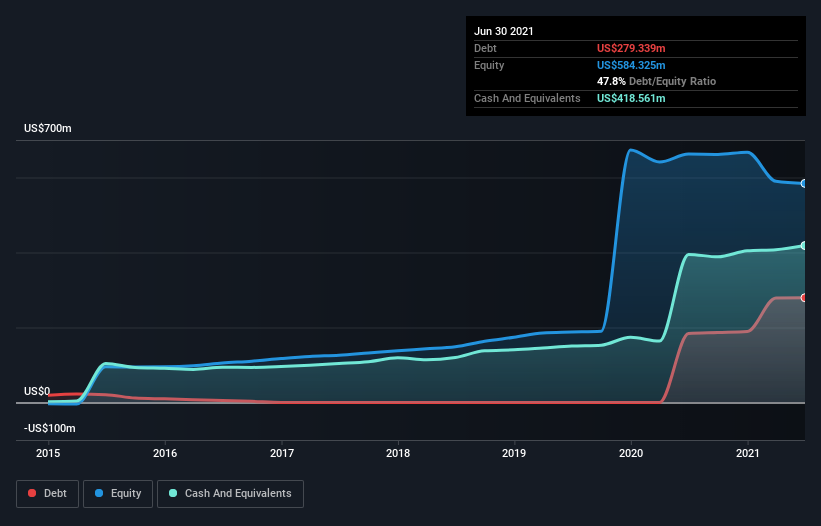Is Glaukos (NYSE:GKOS) Using Too Much Debt?
Some say volatility, rather than debt, is the best way to think about risk as an investor, but Warren Buffett famously said that 'Volatility is far from synonymous with risk.' So it might be obvious that you need to consider debt, when you think about how risky any given stock is, because too much debt can sink a company. As with many other companies Glaukos Corporation (NYSE:GKOS) makes use of debt. But should shareholders be worried about its use of debt?
When Is Debt A Problem?
Debt is a tool to help businesses grow, but if a business is incapable of paying off its lenders, then it exists at their mercy. Part and parcel of capitalism is the process of 'creative destruction' where failed businesses are mercilessly liquidated by their bankers. However, a more usual (but still expensive) situation is where a company must dilute shareholders at a cheap share price simply to get debt under control. Of course, debt can be an important tool in businesses, particularly capital heavy businesses. The first thing to do when considering how much debt a business uses is to look at its cash and debt together.
View our latest analysis for Glaukos
How Much Debt Does Glaukos Carry?
As you can see below, at the end of June 2021, Glaukos had US$279.3m of debt, up from US$184.0m a year ago. Click the image for more detail. But it also has US$418.6m in cash to offset that, meaning it has US$139.2m net cash.
How Healthy Is Glaukos' Balance Sheet?
Zooming in on the latest balance sheet data, we can see that Glaukos had liabilities of US$349.5m due within 12 months and liabilities of US$109.9m due beyond that. Offsetting these obligations, it had cash of US$418.6m as well as receivables valued at US$37.6m due within 12 months. So its total liabilities are just about perfectly matched by its shorter-term, liquid assets.
This state of affairs indicates that Glaukos' balance sheet looks quite solid, as its total liabilities are just about equal to its liquid assets. So it's very unlikely that the US$2.10b company is short on cash, but still worth keeping an eye on the balance sheet. Despite its noteworthy liabilities, Glaukos boasts net cash, so it's fair to say it does not have a heavy debt load! There's no doubt that we learn most about debt from the balance sheet. But ultimately the future profitability of the business will decide if Glaukos can strengthen its balance sheet over time. So if you want to see what the professionals think, you might find this free report on analyst profit forecasts to be interesting.
In the last year Glaukos wasn't profitable at an EBIT level, but managed to grow its revenue by 34%, to US$284m. Shareholders probably have their fingers crossed that it can grow its way to profits.
So How Risky Is Glaukos?
Statistically speaking companies that lose money are riskier than those that make money. And in the last year Glaukos had an earnings before interest and tax (EBIT) loss, truth be told. And over the same period it saw negative free cash outflow of US$19m and booked a US$60m accounting loss. But the saving grace is the US$139.2m on the balance sheet. That means it could keep spending at its current rate for more than two years. Glaukos's revenue growth shone bright over the last year, so it may well be in a position to turn a profit in due course. By investing before those profits, shareholders take on more risk in the hope of bigger rewards. There's no doubt that we learn most about debt from the balance sheet. However, not all investment risk resides within the balance sheet - far from it. For example, we've discovered 3 warning signs for Glaukos that you should be aware of before investing here.
At the end of the day, it's often better to focus on companies that are free from net debt. You can access our special list of such companies (all with a track record of profit growth). It's free.
This article by Simply Wall St is general in nature. We provide commentary based on historical data and analyst forecasts only using an unbiased methodology and our articles are not intended to be financial advice. It does not constitute a recommendation to buy or sell any stock, and does not take account of your objectives, or your financial situation. We aim to bring you long-term focused analysis driven by fundamental data. Note that our analysis may not factor in the latest price-sensitive company announcements or qualitative material. Simply Wall St has no position in any stocks mentioned.
Have feedback on this article? Concerned about the content? Get in touch with us directly. Alternatively, email editorial-team (at) simplywallst.com.

